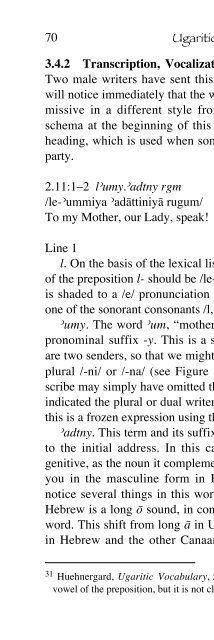A Primer on Ugaritic: Language, Culture, and Literature - enenuru
A Primer on Ugaritic: Language, Culture, and Literature - enenuru
A Primer on Ugaritic: Language, Culture, and Literature - enenuru
Create successful ePaper yourself
Turn your PDF publications into a flip-book with our unique Google optimized e-Paper software.
70<br />
<strong>Ugaritic</strong> <str<strong>on</strong>g>Primer</str<strong>on</strong>g><br />
3.4.2 Transcripti<strong>on</strong>, Vocalizati<strong>on</strong>, <strong>and</strong> Notes (KTU 2.11)<br />
Two male writers have sent this letter to a female superior. You<br />
will notice immediately that the writers of this letter composed this<br />
missive in a different style from KTU 2.10: According to our<br />
schema at the beginning of this chapter, KTU 2.11 has a Type I<br />
heading, which is used when some<strong>on</strong>e sends a letter to a superior<br />
party.<br />
2.11:1–2 l}umy.}adtny rgm<br />
/le-}ummiya }adaœttiniyaœ rugum/<br />
To my Mother, our Lady, speak!<br />
Line 1<br />
l. On the basis of the lexical lists, we know that the vocalizati<strong>on</strong><br />
of the prepositi<strong>on</strong> l- should be /le-/. It seems that the /i/ class vowel<br />
is shaded to a /e/ pr<strong>on</strong>unciati<strong>on</strong> when it occurs in the vicinity of<br />
<strong>on</strong>e of the s<strong>on</strong>orant c<strong>on</strong>s<strong>on</strong>ants /l, m, n, r, y/. 31<br />
}umy. The word }um, “mother,” is in the genitive with the 1cs<br />
pr<strong>on</strong>ominal suffix -y. This is a singular suffix even though there<br />
are two senders, so that we might have expected a dual /-niyaœ/ ora<br />
plural /-ni/ or /-na/ (see Figure 3.9 above or see §7.3.1.3). The<br />
scribe may simply have omitted the letter n that would have clearly<br />
indicated the plural or dual writers of the letter. It may also be that<br />
this is a frozen expressi<strong>on</strong> using the 1cs.<br />
}adtny. This term <strong>and</strong> its suffix, “our lady,” st<strong>and</strong>s in appositi<strong>on</strong><br />
to the initial address. In this case it will be in the same case,<br />
genitive, as the noun it complements. The word may be familiar to<br />
you in the masculine form in Biblical Hebrew, Nwda. You will<br />
notice several things in this word. First, the vowel after the d in<br />
Hebrew is a l<strong>on</strong>g oœ sound, in c<strong>on</strong>trast to the l<strong>on</strong>g aœ of the <strong>Ugaritic</strong><br />
word. This shift from l<strong>on</strong>g aœ in <strong>Ugaritic</strong> (also Akkadian) to l<strong>on</strong>g oœ<br />
in Hebrew <strong>and</strong> the other Canaanite languages is known as “the<br />
31 Huehnergard, <strong>Ugaritic</strong> Vocabulary, 53. Segert (BGUL, §82.1) lengthens the<br />
vowel of the prepositi<strong>on</strong>, but it is not clear why would this happen.


